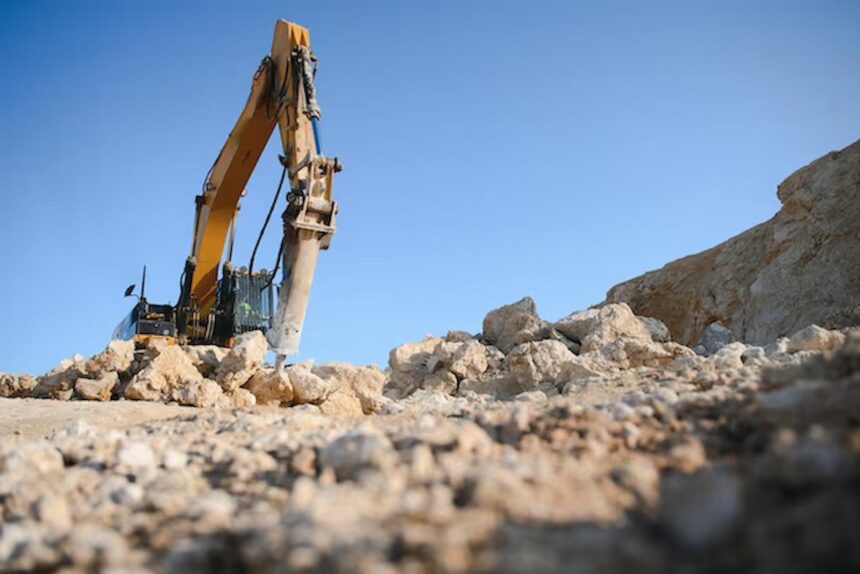Having the right tools is crucial for efficient work in construction, demolition, and excavation. Hydraulic breakers stand out among the various equipment used due to their incredible power and versatility. These machines can break down rigid materials such as concrete, stone, and rock, making them essential for demolition and excavation projects.
Hydraulic breakers are often used when conventional methods fail or take too long. Their high impact force allows for quick and precise work, significantly speeding up the overall process. But what makes these breakers so powerful, and how do they function? This article delves into the details of hydraulic breakers and explains why they are indispensable in construction.
What Are Hydraulic Breakers?
A hydraulic breaker is a heavy-duty tool designed for breaking up hard materials. Powered by hydraulic energy, these breakers are typically mounted on excavators or backhoes. The hydraulic system generates a high-impact force that enables the breaker to deliver powerful blows to rock, concrete, asphalt, and more.
Key Features of Hydraulic Breakers
Piston System: The core component of a hydraulic breaker is the piston, which delivers the impact force.
Hydraulic Fluid: The fluid transfers energy from the excavator’s engine to the breaker, ensuring it delivers maximum force with every hit.
Durable Construction: These tools are built to withstand harsh working environments, ensuring long-lasting reliability.
How Do Hydraulic Breakers Work?
Understanding how hydraulic breakers work helps to appreciate their efficiency. When an excavator or loader arm moves, it activates a hydraulic pump that drives the breaker’s piston. The piston strikes the material with immense force, creating cracks and eventually breaking it apart.
The Role of Hydraulic Pressure
The pressure of the hydraulic fluid determines the intensity of the blow. Higher pressure produces more powerful impacts, which is crucial when working with more rigid materials.
Continuous Impact
Hydraulic breakers provide continuous impact without requiring manual effort, making them highly efficient compared to traditional methods like sledgehammers or jackhammers.
Benefits of Using Hydraulic Breakers
Hydraulic breakers are a game-changer in the construction and demolition industry. They offer numerous benefits that improve efficiency and performance:
Speed and Efficiency
Hydraulic breakers can break through materials faster than manual labour, reducing project timelines.
Versatility
They can be used on various materials, including concrete, rock, and asphalt.
Safety
Using hydraulic breakers minimises the risk of injury to workers by automating the impact process, which reduces the need for manual labour.
Cost-Effectiveness
Faster work means less downtime, translating to overall cost savings for projects. Additionally, fewer labourers are needed, reducing workforce costs.
Applications of Hydraulic Breakers in Demolition and Excavation
Hydraulic breakers are essential for various applications, particularly in demolition and excavation. Some key uses include:
Breaking Concrete
Hydraulic breakers are perfect for demolishing concrete structures like roads, buildings, and bridges. The high impact force enables them to crush reinforced concrete quickly and easily.
Rock Excavation
In mining and quarrying, hydraulic breakers break down rock formations and stone. Their ability to create precise cracks in hard rock helps make excavation quicker and more efficient.
Trenching and Digging
Hydraulic breakers are also valuable in creating trenches for laying pipelines, cables, or foundation work. Their high force breaks up the earth, speeding up the process.
Types of Hydraulic Breakers
Hydraulic breakers come in various sizes and types, each designed for different tasks. The choice of breaker depends on the material to be worked on and the project size.
Light Hydraulic Breakers
These are perfect for smaller jobs, such as breaking up asphalt, curbing, or light concrete. They are usually attached to smaller excavators or skid-steer loaders.
Heavy-Duty Hydraulic Breakers
These breakers are designed for large-scale mining, quarrying, and large demolition projects. They require bigger excavators and generate much higher impact force.
Specialised Attachments
Some breakers have additional features, such as dust suppression systems or vibration control, which increase their effectiveness in specific environments.
Choosing the Right Hydraulic Breaker
Selecting the correct hydraulic breaker is crucial for achieving optimal results. Several factors must be considered to ensure that the breaker suits the job.
Size and Power Requirements
Choose a breaker that matches the size of your excavator or loader. A mismatch can lead to inefficiency and potential damage to equipment.
Material Type
The type of material you are breaking will determine the size and power of the hydraulic breaker. More complex materials like granite require more powerful breakers.
Operating Environment
The breaker’s design should suit the environmental conditions. For example, underwater or high-altitude projects may require specialised breakers.
Cost and Maintenance
Choose a hydraulic breaker that fits your budget, but also consider long-term maintenance costs. Regular servicing is crucial for maintaining performance and prolonging lifespan.
Conclusion
Hydraulic breakers have transformed the demolition and excavation industries. With their exceptional power, speed, and versatility, they are indispensable tools for breaking rigid materials quickly and efficiently. Whether you’re working on large-scale demolition projects, rock excavations, or creating trenches, hydraulic breakers provide the necessary force to get the job done.
Understanding their functionality, benefits, and applications reveals that hydraulic breakers are robust solutions that enhance productivity, reduce costs, and improve safety on the job site. Factors such as material type, equipment compatibility, and long-term maintenance needs must be considered when choosing the correct hydraulic breaker.
With the correct hydraulic breaker, construction projects can be completed with greater precision and efficiency, ensuring timely completion and fewer disruptions. Hydraulic breakers are the ultimate tool for modern demolition and excavation projects.







